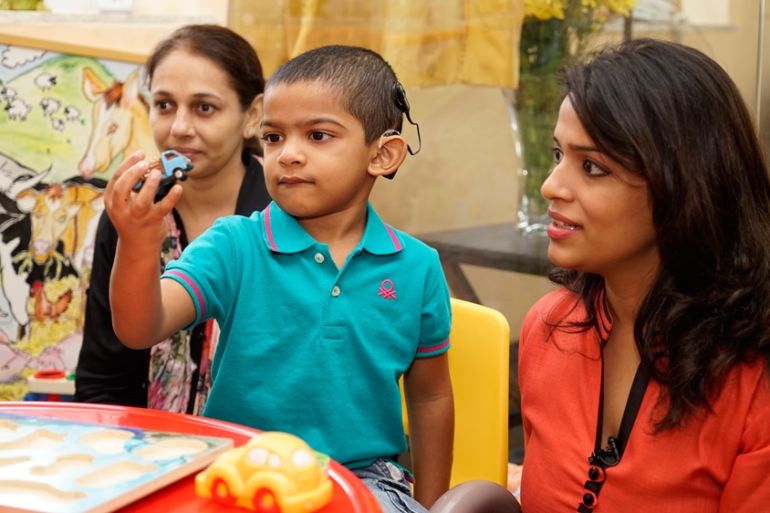Listening to India’s hearing impaired
New technology has helped to lift the burden for those struggling with hearing loss, but more is needed, experts say.

New Delhi – Nearly two decades ago, when Shruti Gupta was diagnosed with congenital hearing loss at the age of one, her life took a dramatic turn.
Her cognitive development, speech retention and ability to respond to loud noises was impaired. Year after year, she visited a specialist to help upgrade and fine-tune her hearing aid. After a decade, she received a cochlear implant and began speech therapy and audiovisual rehabilitation.
Keep reading
list of 4 itemsAmid global polarisation, the pandemic agreement encourages cooperation
Sunak apologises after report finds UK government covered up blood scandal
Philippines plans vaccination drive as whooping cough outbreak claims lives
Today, after learning from her own journey through disability, Gupta is helping others. The third-year undergraduate technology student has created an app called Jellow Communicator India to help other children who struggle with speech impairment. The app, which has been downloaded by more than 1,800 people so far, uses images and icons to help children improve their communication and speech development.
“Today I feel like any other child,” Gupta told Al Jazeera, bubbling with infectious energy. “After going through the agony of hearing loss myself, I decided that there were so many other children who needed this help.”
Gupta’s partner, Ninaad Digital Technology, last week secured innovation funding through UNICEF for the app, which took 19 months to create under the guidance of professors at the Industrial Design Centre at the Indian Institute of Technology Bombay.
Millions affected
An estimated 63 million people suffer from significant hearing loss in India. According to a study by the World Health Organization, five million Indian children were suffering from hearing and speech impairment in 2016.
Shefali Shah, a therapist who treats hearing loss, noted that there are two main types: conductive hearing loss, which affects the passage of sound in the outer and middle ear, and sensorineural hearing loss, which involves the nerves. It is necessary to differentiate between the two types in order to devise the most effective therapy.
Hearing has a huge influence on a child’s development of language and contextual understanding, highlighting the importance of early intervention: “We hear primarily through our brain,” Shah told Al Jazeera.
When Ritu Nakra’s daughter, Ananya, was diagnosed with profound sensorineural hearing loss in 2004, Nakra began a journey of exploring new therapies and hearing aids, while becoming frustrated by the lack of modern technology and the high costs associated with treatment.
“It was a very daunting period of my life,” she told Al Jazeera.
![Within six months of her surgery, Ananya was admitted to one of Delhi's mainstream schools and has since excelled [Courtesy of Ritu Nakra]](/wp-content/uploads/2017/12/701a7978cfbc4f678fb51b8ee55fb4b0_18.jpeg)
Later that same year, Ananya underwent implant surgery, and within six months she was admitted to one of Delhi’s mainstream schools. Today, at 14, she excels academically, performs classical dance and takes part in extracurricular sports.
Deeply affected by her daughter’s journey and the difficulties they faced in reaching this point, Nakra left her well-established career in fashion designing in 2005 to become a special educator with the Rehabilitation Council of India, a government body that monitors and regulates services for people with disabilities.
“It was important to fight against the ignorance related to hearing loss in India,” said Nakra, who today conducts therapy sessions for families suffering from hearing loss.
Although India’s social justice ministry decades ago launched the Ali Yavar Jung National Institute for the Hearing Handicapped in an effort to help provide jobs for the country’s deaf population, experts cite the need for better data management and universal hearing tests for newborn children. People with hearing loss still suffer from social stigma, a lack of employment opportunities and inadequate rehabilitation processes.
This year, the science and technology ministry launched a low-cost screening device to detect congenital hearing loss, but it remains in the early stages of development.
Particularly in India’s rural villages, there remains an awareness gap about the causes of hearing loss and how to deal with it, experts note.
”Hearing loss is not dealt [with] only through having an implant. It involves the necessary collaboration of audiologists, speech language pathologists and ENT [ear, nose and throat] surgeons,” Shah said.
Universal screening
When Rebecca Rajukumar’s four-year-old son, Nahum, underwent surgery for hearing loss, he was almost entirely deaf. During more than a month of recovery, however, he grew comfortable with high-frequency noises, as specialists worked on his cognitive development, brain processing and body language finesse.
“Now my son can have a normal life, friends, secrets and everyday little happiness,” Rajukumar told Al Jazeera.

In India, different state governments have implemented various measures to help children with hearing loss. In Assam, for example, the Gauhati Medical College is providing funding for implants for newborns, pediatric surgeon Nirmal Bhattacharya told Al Jazeera. In Kerala, the government recently made the universal newborn hearing screening test mandatory.
Though hearing loss is a common affliction globally, experts say there are still deficiencies in awareness and the level of attention paid to this issue.
“Early intervention in hearing loss cases is needed right at the time of birth, and better data management services are needed for this process,” Shah noted.